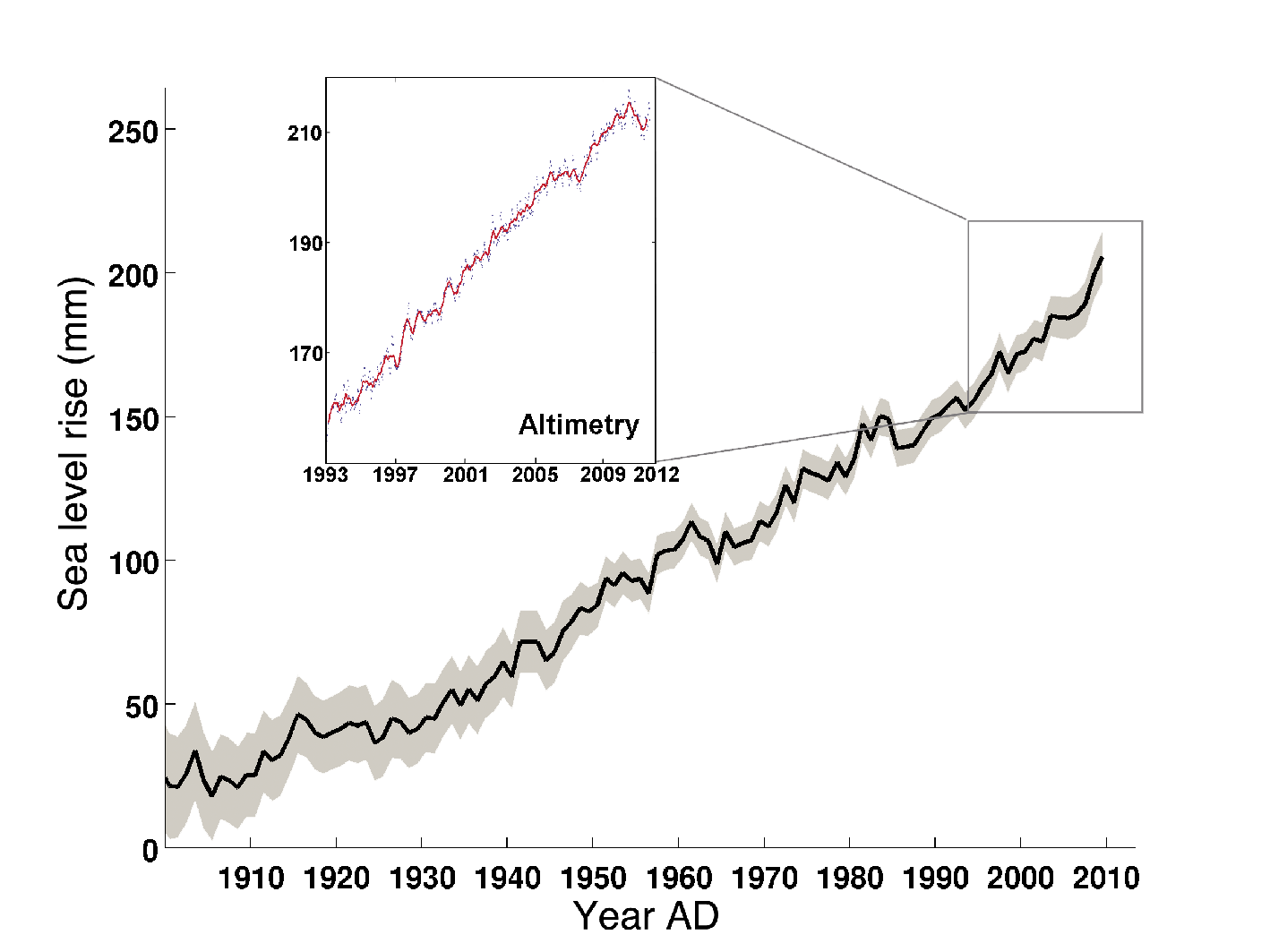- Home
- Publications
- PAGES Magazine
- Sea Level Rise - How Much and How Fast Will Sea Level Rise Over The Coming Centuries? [Present]
Sea level rise - How much and how fast will sea level rise over the coming centuries? [Present]
Anny Cazenave
PAGES news
20(1)
30
2012
Anny Cazenave
Laboratoire d’Etudes en Géophysique et Océanographie Spatiale, Centre National d'Etudes Spatiales, Toulouse, France; anny.cazenave legos.obs-mip.fr
legos.obs-mip.fr
 |
|
Figure 1: Twentieth century sea level curve (in black and associated uncertainty in light gray) based on tide gauge data and additional information (data from Church and White 2011). Box: altimetry-based sea level curve between 1993 and 2011 (data from AVISO; www.aviso.oceanobs.com/en/data/products/sea-surface-height-products/global/msla/index.html). Blue points represent data at 10-day intervals, the red curve their 4-month smoothing (from Meyssignac and Cazenave, unpublished data). |
Sea level is a sensitive indicator of climate change and responds to global warming both directly and indirectly. It rises as oceans warm up and seawater expands, and also as mountain glaciers and ice sheets melt in response to increasing temperature. Tide gauge measurements available since the late 19th century indicate that the global mean sea level has risen by an average of 1.7-1.8 mm year-1 during the 20th century (Church and White 2011), marking the end of the relative stability of the past three millennia. Satellite data available since 1993 point to a higher mean rate of sea-level rise of 3.2±0.4 mm year-1 during the past two decades (Cazenave and Remy 2011).
Ocean temperature data suggest that ocean thermal expansion has significantly increased during the second half of the 20th century, accounting for about 30% of the sea-level rise observed since 1993 (Cazenave and Remy 2011; Church et al. 2011a). Numerous observations have reported a worldwide retreat of glaciers during recent decades, with a significant acceleration of this retreat during the 1990s: this also contributes to about 30% of the sea-level rise. Change in land water storage due to natural climate variability contributes negligibly to sea level rise. Human activities (mostly underground water mining and dam building along rivers) have had large effects on sea level during the past six decades or so, but have mostly canceled each other out (Church et al. 2011a).
Little was known before the 1990s on the mass balance of the ice sheets because of inadequate and incomplete observations. But remote sensing techniques available since then suggest that the Greenland and West Antarctic ice sheets are losing mass at an accelerated rate, mostly from rapid outlet glacier flow and further iceberg discharge into the surrounding ocean (Steffen et al. 2010; Pfeffer 2011). For the period 1993-2003, less than 15% of the rate of global sea-level rise was due to the ice sheets. But their contribution has increased to ~70% since 2003-2004. Although not constant through time, mass loss from the ice sheets explains ~25% of the rate of sea-level rise since the early 1990s (Cazenave and Remy 2011; Church et al. 2011a).
There is little doubt that global warming will continue and even increase during the future decades as greenhouse gas emissions, the main contributor to anthropogenic global warming, are likely to keep growing. Projections from the fourth assessment report of the Intergovernmental Panel on Climate Change (IPCC 2007) indicate that sea level in the year 2100 should be higher than today’s value by ~40 cm (within a range of ±15 cm due to model results dispersion and uncertainty on emissions). More recently it has been suggested that this value could be a lower bound. This is because the climate models at the time accounted for ocean warming and glacial melting (plus a surface mass balance component for the ice sheets) (IPCC 2007), but not for the recently observed dynamical processes that became quite active during the last decade (Steffen et al. 2010; Pfeffer 2011).
Thus, mass loss from ice sheets could eventually represent a much larger contribution to future sea-level rise than previously expected (Pfeffer 2011). Yet, despite much recent progress in process understanding and modeling, the ice sheet contribution to 21st century sea-level rise remains highly uncertain. Values around 30-50 cm by 2100 cannot be ruled out for the total land ice (glaciers plus ice sheets) contribution. If we add the ocean-warming component (in the range 20-30 cm; IPCC 2007), global mean sea level at the end of this century could eventually exceed present-day elevation by 50-80 cm (e.g. Church et al. 2011b).
Providing realistic sea-level projections remains a high priority in the climate modeling community given their importance to developing realistic coastal management and adaptation plans. But sustained and systematic monitoring of sea level and other climate parameters causing sea-level rise – for example, ocean heat content and land ice melt – is also needed. The better we understand present-day sea-level rise and its variability, the better we will be able to project changes in future sea level.
selected references
Full reference list online under: http://pastglobalchanges.org/products/newsletters/ref2012_1.pdf
Cazenave A and Remy F (2011) Interdisciplinary Reviews: Climate Change 2(5): 647-662
Church JA and White NJ (2011) Surveys in Geophysics 32(4-5): 585-602
Church JA et al. (2011a) Geophysical Research Letters 38, doi:10.1029/2011GL048794